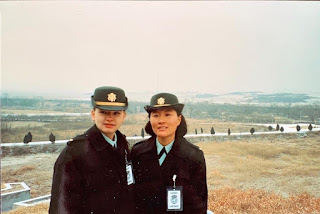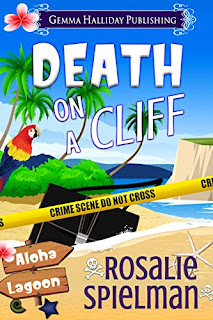As
Monongahela County’s new coroner Zoe Chambers-Adams gears up for a third day
searching for a missing woman, she receives the news she’s been dreading: a
body has been found. What she discovers at the scene leaves no doubt—the
missing woman was violently murdered. Worse, the manner of death mirrors the
Monongahela Strangler case that terrorized the county when Zoe was in high
school. Those murders stopped, but the case was never satisfactorily solved.
And with people arriving in town for Zoe’s twentieth high school reunion, the
memories of those scary days return with a vengeance.
But Zoe’s new husband, Vance Township Police Chief Pete Adams, sees the murder
differently. His investigation reveals two feuding families and a forbidden
relationship between their children. The homicide appears to be a crime of
passion until Pete’s relentless digging unearths a link between his prime
suspect and Zoe’s serial killer. Suddenly, with the predator threatening to
strike someone near and dear to both Zoe and Pete, they must race to uncover
the truth and catch a madman before another innocent victim is brutally
murdered.
Amazon.com

In a
recent blog for WWK, Annette revealed that with the new publisher, the Zoe
Chambers series tone could be darker. When I read, I didn’t notice the change
in tone. For those of you who are old Zoe fans, no need to fear. There is still
the underlying humor even in the face of death and broken relationships. E. B. Davis
One theme
that surfaces time and again throughout the book is that people blame the
victims. Why do people judge children harshly when it’s the parent who is at
fault? The child is a victim of the parent, too!
I’m not a psychologist or a parent, so I may not be the person to
answer, despite having written the story. In this case, the parent in question
truly wants a better life for his son but has a really horrible way of showing
it. He believes he’s right and is the only one who knows what’s best.
Basically, it’s his way or the highway. In the father’s mind, if the child
wants a different path or rebels, then the child is misguided or being
manipulated.
What’s a
Quarter horse gelding?
A Quarter Horse is a breed named because it can run a quarter mile
faster than a Thoroughbred. A gelding is a castrated male horse. They’re more
docile than a stallion (an uncastrated male) and less “moody” than a mare.
Having said that, Zoe’s gelding, Windstar, is named after a horse I once raised
from a foal. Except Zoe’s Windstar is the horse I wished mine had been. My
Windstar bucked me off more times than I can count and broke a few of my bones.
Why doesn’t
Zoe want to go to her twentieth high school reunion?
Zoe was a “wild child” back then and isn’t proud of it. She really
doesn’t want to face that part of her past regardless of how much she has
changed. She figures she has stayed in touch with the people she liked back
then and has no desire to hang out with the others. That last part is what kept
me away from most of my own reunions too! (I was NOT a wild child though. Quite
the opposite.)
I was
surprised that a teacher came to Zoe’s reunion. I don’t think teachers were
invited to mine. Is this a common practice in other places in Pennsylvania?
Ha! Probably not! This is where I drag out the disclaimer about
writing fiction. In my fictional Phillipsburg High School, the reunion
planning committee decided to invite a few of the more popular teachers to the
reunion. In reality, I’ve only attended one of my reunions and there were no
teachers there. I wish there had been! There are several I’d really like to see
again.
Although men are often described as
aging better than women, it seems from 18-38, even with pregnancies, the women
are far more recognizable than the men. Any thoughts on that?
This is simply my own observation of classmates I ran into within
that age range. I never had any problem recognizing the women. The men were
another story. I’ve had several guys from my class come up to me—guys I SHOULD
know—and I had no clue. I decided to give Zoe the same problem, which puts her
in direct conflict with her pal Rose, who insists she recognizes one man in
particular…a man neither of them wants to ever see again.
Abby, one
of Pete’s officers, seems like a careful and in-depth researcher/investigator.
And yet, Pete admonishes her use of a Taser on one suspect and encourages her
to use it on another. What does Pete perceive that Abby doesn’t?
That scene is the result of what I learned from a real police
detective who has been around for a number of years. I pretty much put his
words directly into Pete’s mouth with regards to younger cops relying on new
technology. Pete has been around a while as well, has worked as a Field
Training Officer in the past, and is a mentor to Abby in addition to being her
boss. She’s a good cop, but she hasn’t seen as much or experienced as much as
he has, especially since Pete spent the first half of his career in the city of
Pittsburgh. Abby has always been a small-town peace officer.
As far as his suggestion she use the taser on the other guy, that
was more in jest. He wanted the man in question to think twice before messing
with Abby.
The new
victim of rape and strangulation death reminds everyone of a serial killer who
killed and raped three women during Zoe’s senior year. Rose, who has returned
with her family for the reunion thinks the police targeted the wrong suspect
twenty years ago. She thinks it was the class perv, who she claims to have seen
at the reunion picnic. Someone else backs up her claim. But Zoe is skeptical,
which ticks off Rose. Zoe disproves Roses claim, but then realizes she is
wrong. Is Zoe’s lack of belief crucial in their relationship? Can Rose see that
Zoe is a professional, and she is not?
I don’t believe Rose is thinking about Zoe’s profession in this
case. Rose is being driven by her heart and her fears. Plus she believes what
she has seen with her own eyes and doesn’t appreciate Zoe doubting her. To be
honest, Rose and Zoe’s friendship has been on increasingly rocky ground since
the first book in the series when Rose’s husband was killed. Although the loss
had nothing to do with Zoe, it deeply changed Rose. Even now that she’s happily
remarried, Rose is easily shaken and is constantly afraid of losing those she
loves.
Vince
Quinn, whose new tractor was stolen and taken for a joy ride, is described as a
“surly son of a bitch.” Is there a reason for his manner?
He’s another case of losing a loved one (his son) having changed
him. Even twenty years later, Vince still grieves, and his grief manifests in
anger at everyone and everything. He’s mad at the world. He’s already lost the
most important person in his life and doesn’t care who else gets hurt.
Refresh
our memories of Lauren. She’s a journalist but also a horse owner.
Lauren first showed up in Uneasy Prey as a thorn in Pete’s
side and a possible rival in Zoe’s eyes. Since then, her love of horses helped
her bond with Zoe, and she’s possibly the only journalist Pete doesn’t mind
having around. When Zoe’s cousin, Patsy, moved to Florida, she left her horse
in Lauren’s hands. Now that the move appears permanent, Lauren’s been given the
opportunity to buy the horse outright. And since she boards at Zoe’s farm,
Lauren’s always around.
What
happened to Zoe in high school that gives her such empathy for the murder/rape
victims? Who was Jerry?
To learn about Zoe’s history with Jerry (McBirney), you need to
read Circle of Influence. For me to answer in any detail would be a
major spoiler for that book! Suffice it to say, Zoe was the victim of an
attempted rape, thanks to Jerry.
Zoe
sometimes makes incorrect assumptions. Is that due to lack of investigative
training or her newness in her job?
A bit of both. Zoe went from being a part-time deputy coroner to
full-time deputy coroner and was then thrust into the job of county coroner in
relatively short order. She knows there are gaps in her training, but she’s
really trying!
Abby’s
research shows that sometimes a serial killer/rapist can go dormant for years,
but usually not forever. Is that true?
Yes. I did a lot of reading on the subject (not a pleasant topic)
and learned there are a few, very rare cases, when a sexual predator has
stopped. Emphasis on very rare. But not unheard of.
Often,
it’s the easy suspect, not the correct suspect that the police hound. What does
Marcus see in Gabe that few others (except maybe Pete) see?
Marcus is another character who first showed up in Uneasy Prey,
and he has always been the protector of the underdog and the bullied, although
Gabe definitely doesn’t appear to fit that category at all. Marcus is desperate
to give him the benefit of the doubt, whether Gabe deserves it or not. As for
Pete, he’s always trying to straighten kids out and is known for his “come to
Jesus” talks with troublemakers.
Does Zoe
really need Davis so much that she’s willing to put up with his arrogance and
unprofessional behavior when she’s the boss?
Going back to Zoe’s gaps in training and experience, she believes
she “needs” him. He’s managed to keep her convinced of it for a while now, but
he’s really starting to wear on her last nerve. To him, Zoe is a steppingstone.
He wants that position and believes he’s more qualified. In many ways, Zoe
believes he’s more qualified too, but she also knows she has more empathy for
the victims than Davis will ever have.
(Behind the scenes tidbit: The Davis/Zoe relationship is going to
eventually explode big time.)
Like Zoe’s
cousin Patsy, you seem to be retiring some secondary characters for new ones.
Why? Are you taking the series in a new direction?
I don’t know if I’m “retiring” secondary characters. Just like
real life, people come in and out of Zoe and Pete’s lives. Or maybe they just
don’t have a major role in the current story. Unless a character has been
killed off, there’s always a possibility they’ll show up again.
Why does
Zoe question that she may not be the best person to serve as coroner?
If Franklin Marshall was still alive, Zoe would happily still be
working under him as deputy coroner. His death threw her into the job of
heading up that office. Also, she worked as a paramedic, saving lives, for a
lot of years. She misses the outcome of having her patient survive a trauma.
It’s a different mindset, one that she’s still trying to reconcile. Until she
comes to terms with what she really wants, she’s always going to doubt herself.
What’s
next for Zoe and Pete?
I’m working on book #12, tentatively titled Helpless. In
it, a friend has been shot and left for dead. His wife’s been murdered. His
daughter’s been kidnapped. He knows he’s probably not going to survive, and his
dying wish is that his little girl be rescued from the monster he saw but can’t
identify. And as if that isn’t enough to keep Zoe and Pete busy, a major
hurricane is bearing down on Vance Township. Will they be able to capture the
killer and rescue the missing child before both disappear forever?





.png)
.jpg)














